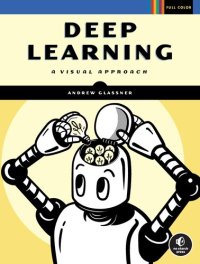
Ebook: Deep Learning: A Visual Approach
Author: Andrew Glassner
- Genre: Computers // Cybernetics: Artificial Intelligence
- Tags: Neural Networks, Deep Learning, Reinforcement Learning, Decision Trees, Convolutional Neural Networks, Recurrent Neural Networks, Autoencoders, Generative Adversarial Networks, Bayesian Inference, Classification, Principal Component Analysis, Support Vector Machines, Performance Metrics, Gradient Descent, Regularization, Ensemble Learning, Attention, Perceptron, Overfitting, Underfitting, Testing, Variational Autoencoders, Transformers, Q-Learning, Information Theory, Backpropagation, Data Preparation, Naïve Bayes
- Year: 2021
- Publisher: No Starch Press
- City: San Francisco, CA
- Edition: 1
- Language: English
- pdf
A richly-illustrated, full-color introduction to deep learning that offers visual and conceptual explanations instead of equations. You'll learn how to use key deep learning algorithms without the need for complex math.
Ever since computers began beating us at chess, they've been getting better at a wide range of human activities, from writing songs and generating news articles to helping doctors provide healthcare.
Deep learning is the source of many of these breakthroughs, and its remarkable ability to find patterns hiding in data has made it the fastest growing field in artificial intelligence (AI). Digital assistants on our phones use deep learning to understand and respond intelligently to voice commands; automotive systems use it to safely navigate road hazards; online platforms use it to deliver personalized suggestions for movies and books - the possibilities are endless.
Deep Learning: A Visual Approach is for anyone who wants to understand this fascinating field in depth, but without any of the advanced math and programming usually required to grasp its internals. If you want to know how these tools work, and use them yourself, the answers are all within these pages. And, if you're ready to write your own programs, there are also plenty of supplemental Python notebooks in the accompanying Github repository to get you going.
The book's conversational style, extensive color illustrations, illuminating analogies, and real-world examples expertly explain the key concepts in deep learning, including:
• How text generators create novel stories and articles
• How deep learning systems learn to play and win at human games
• How image classification systems identify objects or people in a photo
• How to think about probabilities in a way that's useful to everyday life
• How to use the machine learning techniques that form the core of modern AI
Intellectual adventurers of all kinds can use the powerful ideas covered in Deep Learning: A Visual Approach to build intelligent systems that help us better understand the world and everyone who lives in it. It's the future of AI, and this book allows you to fully envision it.
Ever since computers began beating us at chess, they've been getting better at a wide range of human activities, from writing songs and generating news articles to helping doctors provide healthcare.
Deep learning is the source of many of these breakthroughs, and its remarkable ability to find patterns hiding in data has made it the fastest growing field in artificial intelligence (AI). Digital assistants on our phones use deep learning to understand and respond intelligently to voice commands; automotive systems use it to safely navigate road hazards; online platforms use it to deliver personalized suggestions for movies and books - the possibilities are endless.
Deep Learning: A Visual Approach is for anyone who wants to understand this fascinating field in depth, but without any of the advanced math and programming usually required to grasp its internals. If you want to know how these tools work, and use them yourself, the answers are all within these pages. And, if you're ready to write your own programs, there are also plenty of supplemental Python notebooks in the accompanying Github repository to get you going.
The book's conversational style, extensive color illustrations, illuminating analogies, and real-world examples expertly explain the key concepts in deep learning, including:
• How text generators create novel stories and articles
• How deep learning systems learn to play and win at human games
• How image classification systems identify objects or people in a photo
• How to think about probabilities in a way that's useful to everyday life
• How to use the machine learning techniques that form the core of modern AI
Intellectual adventurers of all kinds can use the powerful ideas covered in Deep Learning: A Visual Approach to build intelligent systems that help us better understand the world and everyone who lives in it. It's the future of AI, and this book allows you to fully envision it.
Download the book Deep Learning: A Visual Approach for free or read online
Continue reading on any device:

Last viewed books
Related books
{related-news}
Comments (0)